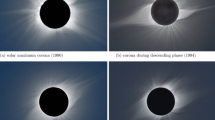Abstract
Global magnetic field calculations, using potential field theory, are performed for Carrington rotations 1601–1610 during the Skylab period. The purpose of these computations is to quantitatively test the spatial correspondence between calculated open and closed field distributions in the solar corona with observed brightness structures. The two types of observed structures chosen for this study are coronal holes representing open geometries and theK-coronal brightness distribution which presumably outlines the closed field regions in the corona. The magnetic field calculations were made using the Adams-Pneuman fixed-mesh potential field code based upon line-of-sight photospheric field data from the KPNO 40-channel magnetograph. Coronal hole data is obtained from AS&E's soft X-ray experiment and NRL's Heii observations and theK-coronal brightness distributions are from HAO'sK-coronameter experiment at Mauna Loa, Hawaii.
The comparison between computed open field line locations and coronal holes shows a generally good correspondence in spatial location on the Sun. However, the areas occupied by the open field seem to be somewhat smaller than the corresponding areas of X-ray holes. Possible explanations for this discrepancy are discussed. It is noted that the locations of open field lines and coronal holes coincide with the locations ofmaximum field strength in the higher corona with the closed regions consisting of relatively weaker fields.
The general correspondence between bright regions in theK-corona and computed closed field regions is also good with the computed neutral lines lying at the top of the closed loops following the same general ‘warped’ path around the Sun as the maxima in the brightness. One curious feature emerging from this comparison is that the neutral lines at a given longitude tend systematically to lie somewhat closer to the poles than the brightness maxima for all rotations considered. This discrepancy in latitude increases as the poles are approached. Three possible explanations for this tendency are given: perspective effects in theK -coronal observations, MHD effects due electric currents not accounted for in the analysis, and reported photospheric field strengths near the poles which are too low. To test this latter hypothesis, we artificially increased the line-of-sight photospheric field strengths above 70° latitude as an input to the magnetic field calculations. We found that, as the polar fields were increased, the discrepancy correspondingly decreased. The best agreement between neutral line locations and brightness maxima is obtained for a polar field of about 30 G.
Similar content being viewed by others
References
Adams, J. and Pneuman, G. W.: 1976,Solar Phys. 46, 185.
Altschuler, M. D.: 1971,Sky Telesc. 41, 2.
Altschuler, M. D., Levine, R. J., Stix, M., and Harvey, J. W.: 1977,Solar Phys. 51, 345.
Bohlin, J. D. and Rubenstein, D. J.: 1975, Report UAG 51, World Data Center A for Solar Terrestrial Physics, NOAA, Boulder, Colo.
Charvin, P.: 1965,Ann. Astrophys. 28, 877.
Durney, B. R. and Pneuman, G. W.: 1975,Solar Phys. 40, 461.
Hansen, R. T., Hansen, S. F., and Sawyer, C.: 1976,Planetary Space Sci. 24, 381.
House, L. L.: 1977,Astrophys. J. 214, 632.
Howard, R.: 1972,Solar Phys. 25, 5.
Hundhausen, A. J.: 1977, in J. Zirker (ed.),Coronal Holes and High Speed Wind Streams, Colo. Assoc. Univ. Press, Boulder, Colo., Chapter 7.
Krieger, A. S., Timothy, A. F., and Roelof, E. C.: 1973,Solar Phys. 29, 505.
Levine, R. H., Altschuler, M. D., Harvey, J. W., and Jackson, B. V.: 1977,Astrophys. J. 215, 636.
Livingston, W. C.: 1972Sky Telesc. 43, 344.
MacQueen, R. M. and Poland, A. I.: 1977,Solar Phys. 55, 143.
Munro, R. H. and Jackson, B. V.: 1977,Astrophys. J. 213, 874.
Newkirk, G. A. and Altschuler, M. D.: 1970,Solar Phys. 13, 131.
Newkirk, G. A., Altschuler, M. D., and Harvey, J.: 1968, in K. O. Kiepenheuer (ed.), ‘Structure and Development of Solar Active Regions’,IAU Symp. 35, 379.
Newkirk, G. A., Trotter, D. E., Altschuler, M. D., and Howard, R.: 1972,Solar Phys. 24, 370.
Nolte, J. T., Krieger, A. S., Timothy, A. F., Gold, R. E., Roelof, E. C., Vaiana, G., Lazarus, A. J., Sullivan, J. D., and McIntosh, P. S.: 1976,Solar Phys. 46, 303.
Pheuman, G. W.: 1973,Solar Phys. 28, 247.
Querfeld, C. W.: 1974, in T. Gehrels (ed.),Planets, Stars, and Nebulae, Univ. of Arizona Press. Tucson, p. 254.
Schatten, K. H.: 1971, in R. Howard (ed.), ‘Solar Magnetic Fields’,IAU Symp. 43, 569.
Severny, A.: 1971, in R. Howard (ed.), Solar Magnetic Fields’,IAU Symp. 43, 675.
Stenflo, J. O.: 1970,Solar Phys. 14, 263.
Suess, S., Richter, A. K., Winge, C. R., and Nerney, S. F.: 1977,Astrophys. J. 217, 296.
Svalgaard, L., Duvall, T. L., and Scherrer, P. H.: 1978,Solar Phys. 58, 225.
Author information
Authors and Affiliations
Additional information
The National Center for Atmospheric Research is sponsored by the National Science Foundation.
Rights and permissions
About this article
Cite this article
Pneuman, G.W., Hansen, S.F. & Hansen, R.T. On the reality of potential magnetic fields in the solar corona. Sol Phys 59, 313–330 (1978). https://doi.org/10.1007/BF00951836
Received:
Issue Date:
DOI: https://doi.org/10.1007/BF00951836




